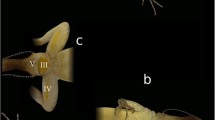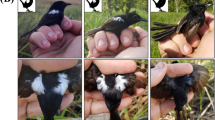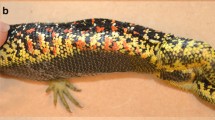Abstract
Males of many species of lizards show conspicuous breeding colors but, in some species, young competitively inferior males conceal their sexual identity by a female-like dull coloration that allows them to evade aggression from dominant males and to adopt an alternative satellite-sneaking mating tactic. However, large males of the lizard Psammodromus algirus reacted aggressively to young intruder males despite their female-like coloration, suggesting that they might have the ability to recognize competitor males by chemosensory cues. We experimentally manipulated the head coloration (brown vs orange) and scents (male vs female) of small young males. For staged agonistic encounters, we compared the response of resident unmanipulated large males to the different manipulated small males. When we manipulated only the color of small males, the response of resident large males was independent of the paint manipulation; brown and orange males elicited a similar aggressive response. However, when we also manipulated the scent, small males painted orange or brown, but bearing the scent of males, received a significantly higher number of aggressive responses than small males painted orange or brown, but bearing the scent of females. The results showed that, at close range, the reaction of large males to manipulated individuals was dependent on the scent, whereas color seemed to be less important. Coloration may be, however, more important in long-distance communication as shown by the outcome of the first encounters. Also, orange coloration may increase the intensity of the aggressive response. Effective sex recognition by territorial large males is important in natural situations to avoid sneak matings by young male competitors. Thus, even if small males visually conceal their sexual identity, chemosensory cues allow large males to identify them at close range.


Similar content being viewed by others
References
Alberts AC (1989) Ultraviolet visual sensitivity in desert iguanas: implications for pheromone detection. Anim Behav 38:129–137
Alberts AC (1992) Pheromone self-recognition in desert iguanas. Copeia 1992:229–232
Andrews TJ, Summers CH (1996) Aggression, and the acquisition and function of social dominance in female Anolis carolinensis. Behaviour 133:1265–1279
Aragón P, López P, Martín J (2001) Chemosensory discrimination of familiar and unfamiliar conspecifics by lizards: implications of field spatial relationships between males. Behav Ecol Sociobiol 50:128–133
Baird TA, Timanus DK (1998) Social inhibition of territorial behaviour in yearling male collared lizards, Crotaphytus collaris. Anim Behav 56:989–994
Baird TA, Acree MA, Sloan CL (1996) Age and gender-related differences in the social behaviour and mating success of free-living collared lizards, Crotaphytus collaris. Copeia 1998:336–347
Bauwens D, Nuitjen K, Van Wezel H, Verheyen RF (1987) Sex recognition by males of the lizard Lacerta vivipara: an introductory study. Amphibia-Reptilia 8:49–57
Cooper WE Jr (1994) Chemical discrimination by tongue-flicking in lizards: a review with hypotheses on its origin and its ecological and phylogenetic relationships. J Chem Ecol 20:439–487
Cooper WE Jr, Greenberg N (1992) Reptilian coloration and behavior. In: Gans C, Crews D (eds) Biology of the Reptilia, vol 18. Brain, hormones, and behavior. University of Chicago Press, Chicago, pp 298–422
Cooper WE Jr, Vitt LJ (1984) Conspecific odor detection by the male broad-headed skink, Eumeces laticeps: effects of sex and site of odor source and of male reproductive condition. J Exp Zool 230:199–209
Cooper WE Jr, Vitt LJ (1987a) Deferred agonistic behavior in a long-lived sicincid lizard Eumeces laticeps. Oecologia 72:321–326
Cooper WE Jr, Vitt LJ (1987b) Intraspecific and interspecific aggression in lizards of the scincid genus Eumeces: chemical detection of conspecific sexual competitors. Herpetologica 43:7–14
Cooper WE Jr, Vitt LJ (1988) Orange head coloration of the male broad-headed skink (Eumeces laticeps), a sexually selected social cue. Copeia 1988:1–6
Cooper WE Jr, Garstka WR, Vitt LJ (1986) Female sex pheromone in the lizard Eumeces laticeps. Herpetologica 42:361–366
Díaz JA (1993) Breeding coloration, mating opportunities, activity, and survival in the lacertid lizard Psammodromus algirus. Can J Zool 71:1104–1110
Díaz JA, Alonso-Gómez AL, Delgado MJ (1994) Seasonal variation of gonadal development, sexual steroids, and lipid reserves in a population of the lizard Psammodromus algirus. J Herpetol 28:199–205
Ferguson GW (1966) Releases of courtship and territorial behaviour in the side blotched lizard, Uta stansburiana. Anim Behav 14:89–92
Fleishman LJ, Loew ER, Leal M (1993) Ultraviolet vision in lizards. Nature 365:397
Halpern M (1992) Nasal chemical senses in reptiles: structure and function. In: Gans C, Crews D (eds) Biology of the Reptilia, vol 18. Brain, hormones, and behavior. University of Chicago Press, Chicago, pp 423–522
Hansen AJ, Rohwer S (1986) Coverable badges and resource defence in birds. Anim Behav 34:69–76
Kodric-Brown A (1986) Satellites and sneakers: opportunistic male breeding tactics in pupfish (Cyprinodon pecosensis). Behav Ecol Sociobiol 19:425–432
López P, Martín J (2001) Fighting rules and rival recognition reduce costs of aggression in male lizards, Podarcis hispanica. Behav Ecol Sociobiol 49:111–116
López P, Martín J (2002) Chemical rival recognition decreases aggression levels in male Iberian wall lizards, Podarcis hispanica. Behav Ecol Sociobiol 51:461–465
López P, Martín J, Cuadrado M (2002) Pheromone mediated intrasexual aggression in male lizards, Podarcis hispanica. Aggr Behav 28:154–163
Madsen T, Loman J (1987) On the role of colour display in the social and spatial organization of male rainbow lizards (Agama agama). Amphibia-Reptilia 8:365–372
Martín J, Forsman A (1999) Social costs and development of nuptial coloration in male Psammodromus algirus lizards: an experiment. Behav Ecol 10:396–400
Mason RT (1992) Reptilian pheromones. In: Gans C, Crews D (eds) Biology of the Reptilia, vol 18. Brain, hormones, and behavior. University of Chicago Press, Chicago, pp 114–228
M'Closkey RT, Deslippe RJ, Szpak CP, Baia KA (1990) Ecological correlates of the variable mating system of an iguanid lizard. Oikos 59:63–69
Noble GK (1937) Sense organs involved in the courtship of Storeria, Thamnophis and other snakes. Bull Am Mus Nat Hist 73:673–725
Olsson M (1992) Contest success in relation to size and residence in male sand lizards, Lacerta agilis. Anim Behav 44:386–388
Olsson M (1994) Nuptial coloration in the sand lizard, Lacerta agilis: an intra-sexually selected cue to fighting ability. Anim Behav 48:607–613
Rohwer S, Fretwell SD, Niles DM (1980) Delayed maturation in passerine plumages and the deceptive aquisition of resources. Am Nat 115:400–437
Ross P, Crews D (1978) Stimuli influencing mating behavior in the garter snake, Thamnophis radix. Behav Ecol Sociobiol 4:133–142
Salvador A, Martín J, López P (1995) Tail loss reduces home range size and access to females in male lizards, Psammodromus algirus. Behav Ecol 6:382–387
Salvador A, Veiga P, Martín J, López P, Abelenda M, Puerta M (1996) The cost of producing a sexual signal: testosterone increases the susceptibility of male lizards to ectoparasitic infestation. Behav Ecol 7:145–150
Salvador A, Veiga P, Martín J, López P (1997) Testosterone supplementation in subordinate small male lizards: consequences for aggressiveness, colour development, and parasite load. Behav Ecol 8:135–139
Sherman PW, Reeve HK, Pfennig DW (1997) Recognition systems. In: Krebs JR, Davies NB (eds) Behavioural ecology: an evolutionary approach, 4th edn. Blackwell, Cambridge, pp 69–98
Siegel S, Castellan NJ (1988) Nonparametric statistics for the behavioral sciences, 2nd edn. McGraw-Hill, New York
Sokal RR, Rohlf FJ (1995) Biometry, 3rd ed. W. H. Freeman, New York
Stamps JA (1977) Social behavior and spacing patterns in lizards. In: Gans C, Tinkle DW (eds) Biology of the Reptilia, vol 7. Academic, New York, pp 265–334
Thompson CW, Moore MC (1991) Throat colour reliably signals status in male tree lizards, Urosaurus ornatus. Anim Behav 42:745–753
Veiga JP (1996) Permanent exposure versus facultative concealment of sexual traits: an experimental study in the house sparrow. Behav Ecol Sociobiol 39:345–352
Wehner R (1997) Sensory systems and behaviour. In: Krebs JR, Davies NB (eds) Behavioural ecology: an evolutionary approach, 4th edn. Blackwell, Cambridge, pp 42–68
Zucker N (1989) Dorsal darkening and territoriality in a wild population of the tree lizard (Urosaurus ornatus). J Herpetol 23:389–398
Acknowledgements
We thank "El Ventorrillo" MNCN Field Station for use of their facilities. Financial support was provided by the projects MCYT BOS2002-00598 (to P.L.), DGESIC PB-98-0505 and MCYT BOS2002-00547 (to J.M.), and DGESIC PB 94-0008 and PB 97-1162 (to M.C.).
Author information
Authors and Affiliations
Corresponding author
Additional information
Communicated by W.E. Cooper
Rights and permissions
About this article
Cite this article
López, P., Martín, J. & Cuadrado, M. Chemosensory cues allow male lizards Psammodromus algirus to override visual concealment of sexual identity by satellite males. Behav Ecol Sociobiol 54, 218–224 (2003). https://doi.org/10.1007/s00265-003-0623-2
Received:
Revised:
Accepted:
Published:
Issue Date:
DOI: https://doi.org/10.1007/s00265-003-0623-2




